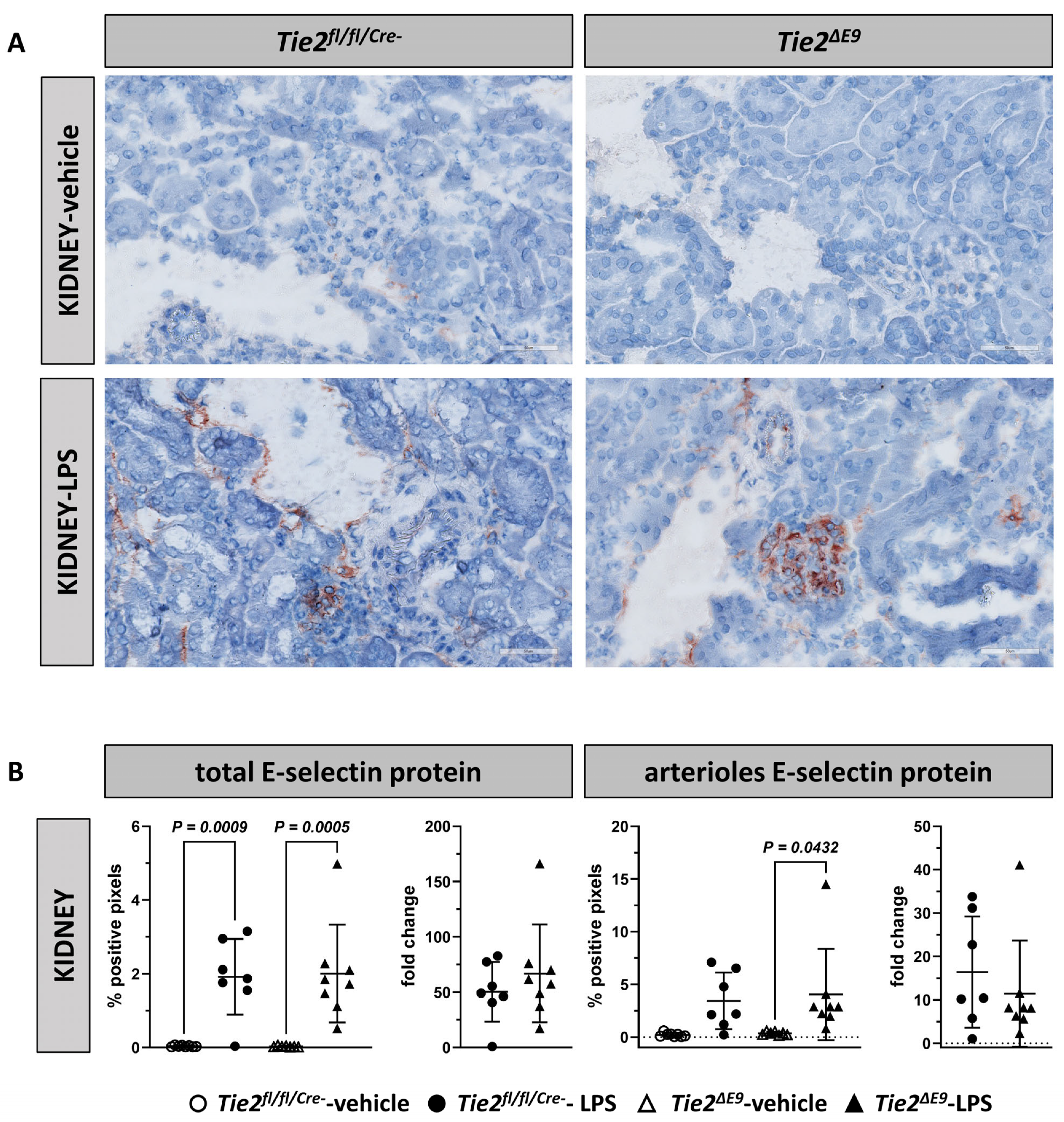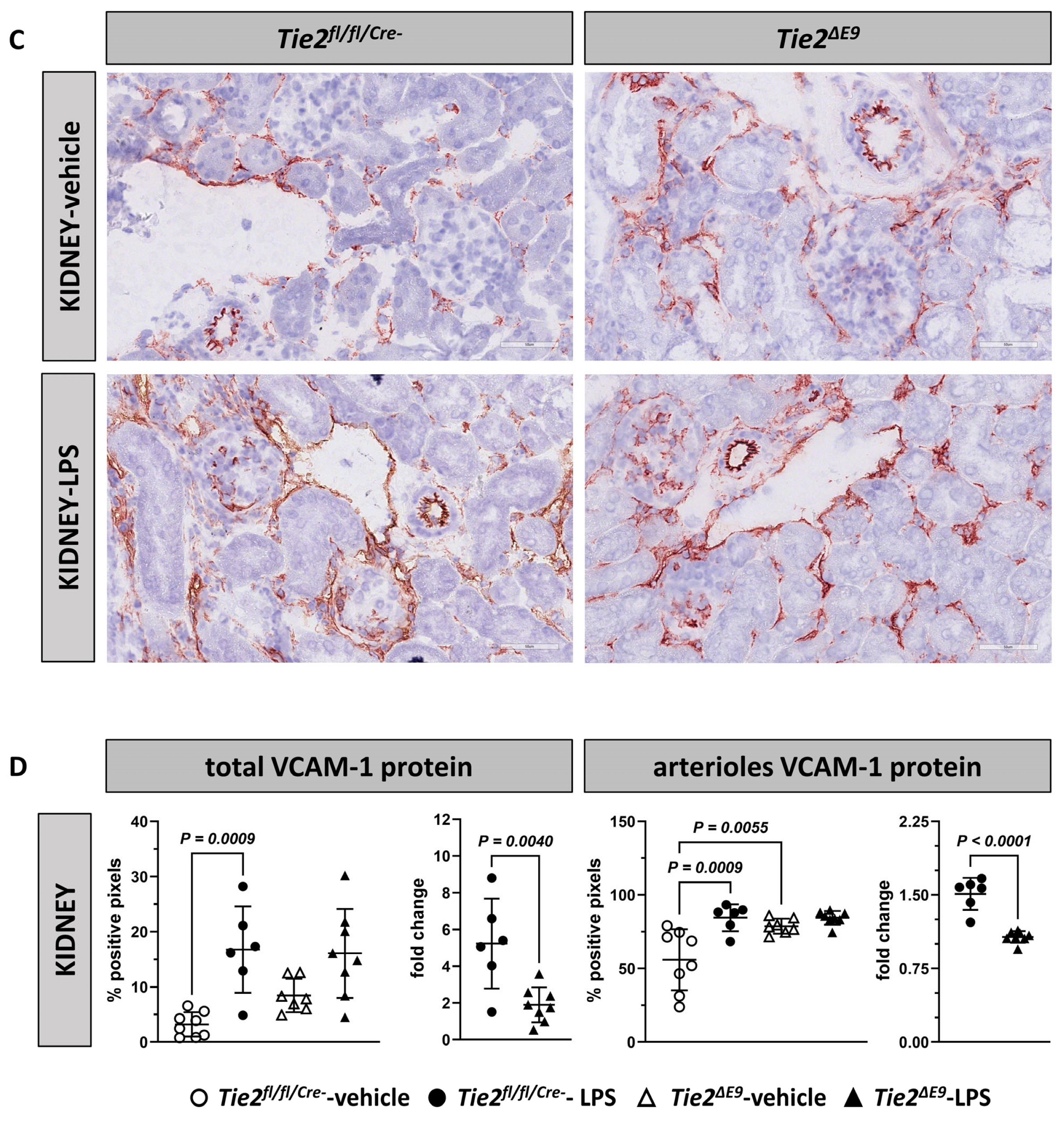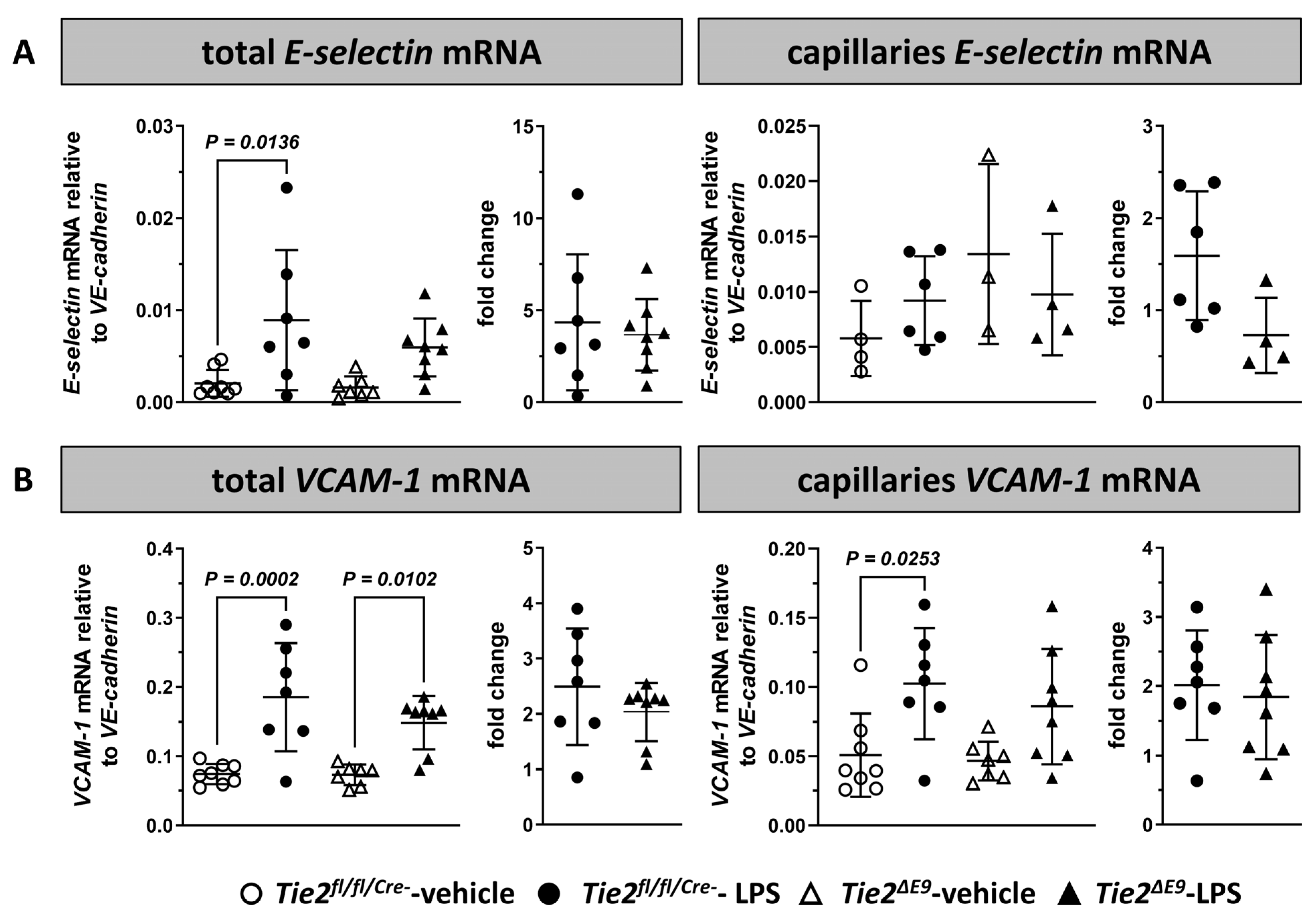Reduced Tie2 in Microvascular Endothelial Cells Is Associated with Organ-Specific Adhesion Molecule Expression in Murine Health and Endotoxemia
Abstract
1. Introduction
2. Materials and Methods
2.1. Generation of Tie2ΔE9 Knockout Mice and Endotoxemia Model
2.2. RNA Isolation and Quantification of Gene Expression by RT-qPCR
2.3. Isolation of Renal Microvascular Compartments by Laser Microdissection
2.4. Tie2 Protein Quantification by ELISA
2.5. Localization of Tie2, E-Selectin, and VCAM-1 Protein by Immunohistochemistry
2.6. Morphometric Quantification of Tie2, E-Selectin, and VCAM-1 Staining in Microvascular Compartments
2.7. Statistical Analysis
3. Results
3.1. Effect of Lower Tie2 Levels on Tie2 mRNA and Protein Expression in Endotoxemia in Mice
3.2. In Kidneys, Tamoxifen-Induced Reduced Tie2 Expression in Arterioles Did Not Affect E-Selectin and VCAM-1 mRNA Levels in Response to LPS Challenge
3.3. In Kidneys, Tamoxifen-Induced Reduced Tie2 Expression in Arterioles Was Associated with Higher Basal VCAM-1 Protein Expression, Yet Did Not Affect LPS Induced E-Selectin and VCAM-1 Protein Expression
3.4. In Lungs, Tamoxifen-Induced Reduced Tie2 Expression Did Not Affect E-Selectin or VCAM-1 mRNA Levels in Response to LPS
3.5. In Lungs, Tamoxifen-Induced Reduced Tie2 Expression Was Associated with Higher E-Selectin Protein Levels in Response to LPS
4. Discussion
Supplementary Materials
Author Contributions
Funding
Institutional Review Board Statement
Data Availability Statement
Acknowledgments
Conflicts of Interest
References
- Jarczak, D.; Kluge, S.; Nierhaus, A. Sepsis—Pathophysiology and Therapeutic Concepts. Front. Med. 2021, 8, 628302. [Google Scholar] [CrossRef]
- Rudd, K.E.; Johnson, S.C.; Agesa, K.M.; Shackelford, K.A.; Tsoi, D.; Kievlan, D.R.; Colombara, D.V.; Ikuta, K.S.; Kissoon, N.; Finfer, S.; et al. Global, Regional, and National Sepsis Incidence and Mortality, 1990–2017: Analysis for the Global Burden of Disease Study. Lancet 2020, 395, 200–211. [Google Scholar] [CrossRef]
- Arora, J.; Mendelson, A.A.; Fox-Robichaud, A. Sepsis: Network Pathophysiology and Implications for Early Diagnosis. Am. J. Physiol. Integr. Comp. Physiol. 2023, 324, R613–R624. [Google Scholar] [CrossRef]
- van Hinsbergh, V.W.M. Endothelium—Role in Regulation of Coagulation and Inflammation. Semin. Immunopathol. 2012, 34, 93–106. [Google Scholar] [CrossRef]
- Cavaillon, J.; Singer, M.; Skirecki, T. Sepsis Therapies: Learning from 30 Years of Failure of Translational Research to Propose New Leads. EMBO Mol. Med. 2020, 12, e10128. [Google Scholar] [CrossRef]
- Gourd, N.M.; Nikitas, N. Multiple Organ Dysfunction Syndrome. J. Intensive Care Med. 2020, 35, 1564–1575. [Google Scholar] [CrossRef]
- Fiedler, U.; Scharpfenecker, M.; Koidl, S.; Hegen, A.; Grunow, V.; Schmidt, J.M.; Kriz, W.; Thurston, G.; Augustin, H.G. The Tie-2 Ligand Angiopoietin-2 Is Stored in and Rapidly Released upon Stimulation from Endothelial Cell Weibel-Palade Bodies. Blood 2004, 103, 4150–4156. [Google Scholar] [CrossRef]
- Roviezzo, F.; Tsigkos, S.; Kotanidou, A.; Bucci, M.; Brancaleone, V.; Cirino, G.; Papapetropoulos, A. Angiopoietin-2 Causes Inflammation in Vivo by Promoting Vascular Leakage. J. Pharmacol. Exp. Ther. 2005, 314, 738–744. [Google Scholar] [CrossRef]
- Kümpers, P.; Gueler, F.; David, S.; Van Slyke, P.; Dumont, D.J.; Park, J.K.; Bockmeyer, C.L.; Parikh, S.M.; Pavenstädt, H.; Haller, H.; et al. The Synthetic Tie2 Agonist Peptide Vasculotide Protects against Vascular Leakage and Reduces Mortality in Murine Abdominal Sepsis. Crit. Care 2011, 15, R261. [Google Scholar] [CrossRef]
- Kim, D.H.; Jung, Y.J.; Lee, A.S.; Lee, S.; Kang, K.P.; Lee, T.H.; Lee, S.Y.; Jang, K.Y.; Moon, W.S.; Choi, K.S.; et al. COMP-Angiopoietin-1 Decreases Lipopolysaccharide-Induced Acute Kidney Injury. Kidney Int. 2009, 76, 1180–1191. [Google Scholar] [CrossRef]
- Hughes, D.P.; Marron, M.B.; Brindle, N.P.J. The Antiinflammatory Endothelial Tyrosine Kinase Tie2 Interacts with a Novel Nuclear Factor-ΚB Inhibitor ABIN-2. Circ. Res. 2003, 92, 630–636. [Google Scholar] [CrossRef] [PubMed]
- Witzenbichler, B.; Westermann, D.; Knueppel, S.; Schultheiss, H.-P.; Tschope, C. Protective Role of Angiopoietin-1 in Endotoxic Shock. Circulation 2005, 111, 97–105. [Google Scholar] [CrossRef] [PubMed]
- Fiedler, U.; Reiss, Y.; Scharpfenecker, M.; Grunow, V.; Koidl, S.; Thurston, G.; Gale, N.W.; Witzenrath, M.; Rosseau, S.; Suttorp, N.; et al. Angiopoietin-2 Sensitizes Endothelial Cells to TNF-Alpha and Has a Crucial Role in the Induction of Inflammation. Nat. Med. 2006, 12, 235–239. [Google Scholar] [CrossRef] [PubMed]
- Echavarria, R.; Mayaki, D.; Neel, J.-C.; Harel, S.; Sanchez, V.; Hussain, S.N.A. Angiopoietin-1 Inhibits Toll-like Receptor 4 Signalling in Cultured Endothelial Cells: Role of MiR-146b-5p. Cardiovasc. Res. 2015, 106, 465–477. [Google Scholar] [CrossRef]
- Harney, A.S.; Karagiannis, G.S.; Pignatelli, J.; Smith, B.D.; Kadioglu, E.; Wise, S.C.; Hood, M.M.; Kaufman, M.D.; Leary, C.B.; Lu, W.-P.; et al. The Selective Tie2 Inhibitor Rebastinib Blocks Recruitment and Function of Tie2 Hi Macrophages in Breast Cancer and Pancreatic Neuroendocrine Tumors. Mol. Cancer Ther. 2017, 16, 2486–2501. [Google Scholar] [CrossRef]
- Dumont, D.J.; Gradwohl, G.; Fong, G.H.; Puri, M.C.; Gertsenstein, M.; Auerbach, A.; Breitman, M.L. Dominant-Negative and Targeted Null Mutations in the Endothelial Receptor Tyrosine Kinase, Tek, Reveal a Critical Role in Vasculogenesis of the Embryo. Genes Dev. 1994, 8, 1897–1909. [Google Scholar] [CrossRef]
- Zwiers, P.J.; Jongman, R.M.; Kuiper, T.; Moser, J.; Stan, R.V.; Göthert, J.R.; van Meurs, M.; Popa, E.R.; Molema, G. Pattern of Tamoxifen-Induced Tie2 Deletion in Endothelial Cells in Mature Blood Vessels Using Endo SCL-Cre-ERT Transgenic Mice. PLoS ONE 2022, 17, e0268986. [Google Scholar] [CrossRef]
- Göthert, J.R.; Gustin, S.E.; Van Eekelen, J.A.M.; Schmidt, U.; Hall, M.A.; Jane, S.M.; Green, A.R.; Go, B.; Izon, D.J.; Begley, C.G. Genetically Tagging Endothelial Cells in Vivo: Bone Marrow–Derived Cells Do Not Contribute to Tumor Endothelium. Blood 2004, 104, 1769–1777. [Google Scholar] [CrossRef]
- Jongman, R.M.; Zwiers, P.J.; van de Sluis, B.; van der Laan, M.; Moser, J.; Zijlstra, J.G.; Dekker, D.; Huijkman, N.; Moorlag, H.E.; Popa, E.R.; et al. Partial Deletion of Tie2 Affects Microvascular Endothelial Responses to Critical Illness in a Vascular Bed and Organ-Specific Way. Shock 2019, 51, 757–769. [Google Scholar] [CrossRef]
- Bustin, S.A.; Benes, V.; Garson, J.A.; Hellemans, J.; Huggett, J.; Kubista, M.; Mueller, R.; Nolan, T.; Pfaffl, M.W.; Shipley, G.L.; et al. The MIQE Guidelines: Minimum Information for Publication of Quantitative Real-Time PCR Experiments. Clin. Chem. 2009, 55, 611–622. [Google Scholar] [CrossRef]
- Yan, R.; van Meurs, M.; Popa, E.R.; Li, R.; Zwiers, P.J.; Zijlstra, J.G.; Moser, J.; Molema, G. Early Heterogenic Response of Renal Microvasculature to Hemorrhagic Shock/Resuscitation and the Influence of NF-ΚB Pathway Blockade. Shock 2019, 51, 200–212. [Google Scholar] [CrossRef] [PubMed]
- van Meurs, M.; Kurniati, N.F.; Wulfert, F.M.; Asgeirsdottir, S.A.; de Graaf, I.A.; Satchell, S.C.; Mathieson, P.W.; Jongman, R.M.; Kümpers, P.; Zijlstra, J.G.; et al. Shock-Induced Stress Induces Loss of Microvascular Endothelial Tie2 in the Kidney Which Is Not Associated with Reduced Glomerular Barrier Function. Am. J. Physiol. Physiol. 2009, 297, F272–F281. [Google Scholar] [CrossRef] [PubMed]
- Sörensen, I.; Adams, R.H.; Gossler, A. DLL1-Mediated Notch Activation Regulates Endothelial Identity in Mouse Fetal Arteries. Blood 2009, 113, 5680–5688. [Google Scholar] [CrossRef]
- Xiao, L.; Liu, Y.; Wang, N. New Paradigms in Inflammatory Signaling in Vascular Endothelial Cells. Am. J. Physiol. Heart Circ. Physiol. 2014, 306, H317–H325. [Google Scholar] [CrossRef] [PubMed]
- Smith, T.L.; Van Slyke, P.; Jones, N.; Dumont, D.J.; McGlade, C.J. Tie2 Signalling through Erk1/2 Regulates TLR4 Driven Inflammation. Cell. Signal. 2018, 51, 211–221. [Google Scholar] [CrossRef]
- Van Der Ent, M.A.; David, M.S.; Cleuren, A.C.A. Molecular Analysis of Vascular Gene Expression. Res. Pract. Thromb. Haemost. 2022, 6, e12718. [Google Scholar] [CrossRef] [PubMed]
- Merritt, C.R.; Ong, G.T.; Church, S.E.; Barker, K.; Danaher, P.; Geiss, G.; Hoang, M.; Jung, J.; Liang, Y.; McKay-Fleisch, J.; et al. Multiplex Digital Spatial Profiling of Proteins and RNA in Fixed Tissue. Nat. Biotechnol. 2020, 38, 586–599. [Google Scholar] [CrossRef]
- Skalicky, S.; Zwiers, P.J.; Kuiper, T.; Schraml, E.; Hackl, M.; Molema, G. Combining Laser Microdissection and MicroRNA Expression Profiling to Unmask MicroRNA Signatures in Complex Tissues. Biotechniques 2019, 67, 276–285. [Google Scholar] [CrossRef]
- Lewis, A.J.; Yuan, D.; Zhang, X.; Angus, D.C.; Rosengart, M.R.; Seymour, C.W. Use of Biotelemetry to Define Physiology-Based Deterioration Thresholds in a Murine Cecal Ligation and Puncture Model of Sepsis. Crit. Care Med. 2016, 44, e420–e431. [Google Scholar] [CrossRef]
- Dayang, E.Z.; Plantinga, J.; Ter Ellen, B.; Van Meurs, M.; Molema, G.; Moser, J. Identification of LPS-Activated Endothelial Subpopulations with Distinct Inflammatory Phenotypes and Regulatory Signaling Mechanisms. Front. Immunol. 2019, 10, 1169. [Google Scholar] [CrossRef]
- Luxen, M.; van Meurs, M.; Molema, G. Unlocking the Untapped Potential of Endothelial Kinase and Phosphatase Involvement in Sepsis for Drug Treatment Design. Front. Immunol. 2022, 13, 867625. [Google Scholar] [CrossRef] [PubMed]
- Fries, J.W.U.; Williams, A.J.; Atkins, R.C.; Newman, W.; Lipscomb, M.F.; Collins, T. Expression of VCAM-1 and E-Selectin in an in Vivo Model of Endothelial Activation. Am. J. Pathol. 1993, 143, 725–737. [Google Scholar] [PubMed]
- Jambusaria, A.; Hong, Z.; Zhang, L.; Srivastava, S.; Jana, A.; Toth, P.T.; Dai, Y.; Malik, A.B.; Rehman, J. Endothelial Heterogeneity across Distinct Vascular Beds during Homeostasis and Inflammation. Elife 2020, 9, e51413. [Google Scholar] [CrossRef] [PubMed]
- Fang, Y.; Li, C.; Shao, R.; Yu, H.; Zhang, Q. The Role of Biomarkers of Endothelial Activation in Predicting Morbidity and Mortality in Patients with Severe Sepsis and Septic Shock in Intensive Care: A Prospective Observational Study. Thromb. Res. 2018, 171, 149–154. [Google Scholar] [CrossRef] [PubMed]








| Gene | Assay ID | Encoded Protein |
|---|---|---|
| Gapdh | Mm99999915_g1 | Glyceraldehyde-3-phosphate dehydrogenase (Gapdh) |
| Tek | Mm00443242_m1 | Tyrosine kinase receptor (Tie2), CD202 |
| Cdh5 | Mm00486938_m1 | Cadherin 5 (VE-cadherin) |
| Esel | Mm00441278_m1 | Endothelial Leukocyte Adhesion Molecule 1, E-selectin |
| VCAM-1 | Mm00449197_m1 | Vascular Cell Adhesion Molecule 1 |
Disclaimer/Publisher’s Note: The statements, opinions and data contained in all publications are solely those of the individual author(s) and contributor(s) and not of MDPI and/or the editor(s). MDPI and/or the editor(s) disclaim responsibility for any injury to people or property resulting from any ideas, methods, instructions or products referred to in the content. |
© 2023 by the authors. Licensee MDPI, Basel, Switzerland. This article is an open access article distributed under the terms and conditions of the Creative Commons Attribution (CC BY) license (https://creativecommons.org/licenses/by/4.0/).
Share and Cite
Zwiers, P.J.; Lucas, J.P.F.E.; Jongman, R.M.; van Meurs, M.; Popa, E.R.; Molema, G. Reduced Tie2 in Microvascular Endothelial Cells Is Associated with Organ-Specific Adhesion Molecule Expression in Murine Health and Endotoxemia. Cells 2023, 12, 1850. https://doi.org/10.3390/cells12141850
Zwiers PJ, Lucas JPFE, Jongman RM, van Meurs M, Popa ER, Molema G. Reduced Tie2 in Microvascular Endothelial Cells Is Associated with Organ-Specific Adhesion Molecule Expression in Murine Health and Endotoxemia. Cells. 2023; 12(14):1850. https://doi.org/10.3390/cells12141850
Chicago/Turabian StyleZwiers, Peter J., Jacqueline P. F. E. Lucas, Rianne M. Jongman, Matijs van Meurs, Eliane R. Popa, and Grietje Molema. 2023. "Reduced Tie2 in Microvascular Endothelial Cells Is Associated with Organ-Specific Adhesion Molecule Expression in Murine Health and Endotoxemia" Cells 12, no. 14: 1850. https://doi.org/10.3390/cells12141850
APA StyleZwiers, P. J., Lucas, J. P. F. E., Jongman, R. M., van Meurs, M., Popa, E. R., & Molema, G. (2023). Reduced Tie2 in Microvascular Endothelial Cells Is Associated with Organ-Specific Adhesion Molecule Expression in Murine Health and Endotoxemia. Cells, 12(14), 1850. https://doi.org/10.3390/cells12141850







